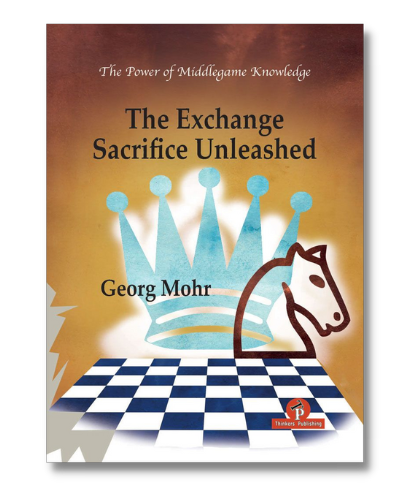The art of the exchange sacrifice is a difficult one to master. Chess players are happy enough to sacrifice pawns left, right, and center in the opening and think nothing of blasting open a castled king’s position with a knight or bishop sacrifice.
Yet the timing of an exchange sacrifice (rook for knight or bishop) is much more difficult, especially when the compensation is not immediately obvious and, indeed, could take many more moves to manifest itself.

The Exchange Sacrifice Unleashed by George Mohr provides excellent coverage of the genre. This new book offers plenty of guidance and examples on this tricky subject, with the exchange sacrifices coming at all stages of the game and in a variety of circumstances, such as attack and defense. There is even a section on World Champions sacrificing the exchange.
Here are some interesting examples from the book.
The Exchange Sacrifice Unleashed: Example 1
Dreev – Peng
Beijing 2000
Black’s bishop appears to be a nuisance but after 25. Rxg3! hxg3 the unexpected follow-up 26. Rb3! brought White success down the g-file (1-0, 29).
The Exchange Sacrifice Unleashed: Example 2
Hort – Petrosian
Kapfenberg 1970
Petrosian is still the undisputed king of the exchange sacrifice and here is a typical example of his style. It looks like White has built up considerable pressure against the black king, but Petrosian was ready with one of his logic-defying specialties.
21…g6! 22. Nf6+ Rxf6 23. exf6 Nf7 when Hort’s attack had been stopped in its tracks and Petrosian went on to prove his superior endgame skills, despite always being the exchange down (0-1, 48).
The Exchange Sacrifice Unleashed: Example 3
Here is a very rare example of a double rook sacrifice on the same square.
Shirov—Short
Yerevan, 1996
15. Rxf6!?
Typical Shirov!
15…gxf6
16. Nd1 a remarkably cool follow up, sending the knight on a journey to g4, from where it will apply significant pressure to both f6 and h6. After the more obvious 16. Rxf6, Black appears to be fine after 16…Ng6, despite his compromised pawn structure.
Fast forward a few moves and we can see exactly what Shirov was up to.
20. Rxf6!
Now 20…Nxf6 21. Qxh6+ and 22. Nxf6+ would be intolerable for Black, so he had to give up his queen with 20…Qxf6. The position became extremely unusual, but Shirov eventually triumphed (1-0, 60).
Playing through the examples given in this entertaining and instructive book will remind the reader that there is far more to chess than merely ‘banking’ a material advantage. Sometimes, a little investment can lead to impressive dividends further down the line.
Sean Marsh
- The Life and Games of Dragoljub Velimirovic (Volume 2) by Georg Mohr and Ana Velimirovic-Zorica - July 23, 2024
- Review: Chess Informant - June 7, 2024
- Is it time for a Modern Benoni revival - April 17, 2024

